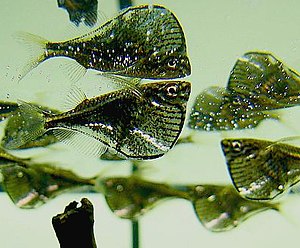Black-winged hatchetfish
| Black-winged hatchetfish | ||||||||||||
|---|---|---|---|---|---|---|---|---|---|---|---|---|

Carnegiella marthae |
||||||||||||
| Systematics | ||||||||||||
|
||||||||||||
| Scientific name | ||||||||||||
| Carnegiella marthae | ||||||||||||
| ( Myers , 1927) |
The black-winged hatchet-bellied fish ( Carnegiella marthae ) is one of the tetras of smaller rivers in the Amazon region . It occurs in Brazil and Venezuela in the northern catchment area of the Orinoco and Rio Negro as well as in Peru and Bolivia .
features
The black-winged hatchet-bellied fish reaches a body length of 3 to 3.5 cm. He has for Hatchetfishes typical flattened body shape with the strongly curved belly, a straight back line and the Upper permanent mouth . Its shiny, silvery flanks show a pattern of fine dark lines running backwards. Its pectoral fins have a light dark gray color, which is responsible for its name.
Way of life
In its natural habitat , the black-winged hatchet-bellied fish prefers the open water surface near dense vegetation, where it feeds mainly on approach food (insects that fall on the water surface), but also on small insect larvae near the surface. It is peaceful and sociable in larger groups, often sympathetic with the marbled hatchet-bellied fish . The waters at the sites are almost without exception very soft and acidic to very acidic . The water temperature is usually between 23 and 27 ° C.
Aquaristics
The black-winged hatchet-bellied fish is an aquarium fish that has not yet been bred according to plan. It is therefore only sold in the wild in the pet trade, mostly as a by-catch of the marbled hatchet-bellied fish. Since it is often not recognized by laypeople among these, it is often acquired and cared for as a marbled hatchet-bellied fish.
It can be kept in aquariums with a pool length of 60 cm or more and in groups of 5 or more animals. The pool should offer free swimming space on the surface of the water and protection through dense border planting and / or overhanging land plants or roots. A light current is an advantage. The black-winged hatchet-bellied fish is described as the most sensitive of the hatchet-bellied tetra. Water values and diet should therefore come close to natural conditions. After getting used to it, fine dry food is also accepted.
When hectic fiddling around in the pool, hatchet-bellied tetra can quickly jump out of the aquarium following their instinct to flee and injure themselves in the process, appropriate caution is required. The aquarium should also be well covered to avoid losses.
Systematics
The black- winged hatchet-bellied fish is closely related to Carnegiella schereri , which lacks the dark coloring in the pectoral fins and whose fine line pattern is less pronounced than that of the black- winged hatchet-bellied fish.
He continues phylogenetically within the C. strigata - species flock and is closer to the in northwestern Brazil in Barcelos occurring C. strigata related -Population than this for. B. with the C. strigata population found in the western state of Acre .
literature
- Wolfgang Staeck: Tetra from South America. Verlag Dähne 2008, ISBN 3-935175-41-8
- Hans A. Baensch : Aquarien Atlas 1. Verlag Mergus 2006, paperback edition, ISBN 3-88244-227-1
- Helmut Pinter: Handbuch der Aquarienfischzucht , Verlag Eugen Ulmer, 1998, ISBN 3-8001-7391-3
Individual evidence
- ↑ Kelly T. Abe, Tatiane C. Mariguela, Gleisy S. Avelino, Ricardo MC Castro, Claudio Oliveira: Multilocus molecular phylogeny of Gasteropelecidae (Ostariophysi: Characiformes) reveals the existence of an unsuspected diversity. Molecular Phylogenetics and Evolution, July 2013, doi: 10.1016 / j.ympev.2013.07.005
Web links
- Black-winged hatchetfish on Fishbase.org (English)